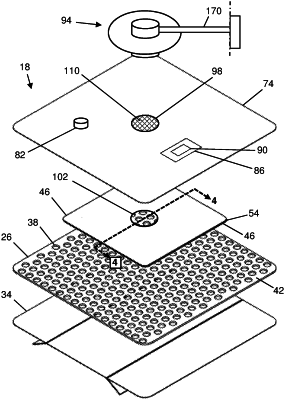| CPC A61F 13/05 (2024.01) [A61M 1/85 (2021.05); A61M 1/915 (2021.05); A61M 1/94 (2021.05); A61M 1/964 (2021.05); A61M 2202/0208 (2013.01); A61M 2205/7536 (2013.01)] | 5 Claims |

|
1. A dressing for facilitating delivery of oxygen to target tissue, the dressing comprising:
a manifold that defines a plurality of gas passageways and is configured to allow communication of oxygen to the target tissue;
a liquid control layer having a plurality of apertures having a planform area that changes in response to fluid flow, the liquid control layer configured to be disposed between the manifold and the target tissue to restrict communication of exudate toward the target tissue;
a patient-interface layer configured to be disposed below the manifold and in contact with the tissue surrounding the target tissue, the patient-interface layer defining a plurality of openings configured to allow communication of oxygen and exudate through the patient-interface layer, the plurality of openings misaligned with the plurality of apertures of the liquid control layer;
a gas-occlusive layer configured to be disposed over the manifold and coupled to tissue surrounding the target tissue such that:
an interior volume is defined between the gas-occlusive layer and the target tissue; and
the gas-occlusive layer limits escape of oxygen from the interior volume between the gas-occlusive layer and the tissue surrounding the target tissue; and
a port coupled to the gas-occlusive layer, wherein the port is configured to be releasably coupled to an oxygen-generating device and to allow fluid communication of oxygen between the oxygen-generating device and the interior volume.
|